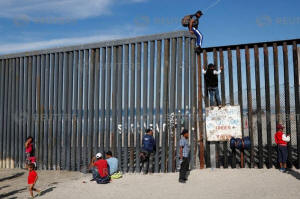|
Migrants in Tijuana feel squeeze from
both sides of U.S. border
 Send a link to a friend
Send a link to a friend
[November 17, 2018]
By Lizbeth Diaz
TIJUANA, Mexico (Reuters) - Central
American migrants on Mexico's northern border are coming under pressure
from two sides as the Trump administration blocks asylum to anyone
entering the United States illegally, while local politicians question
whether they should be in Mexico.
U.S. President Donald Trump has sent almost 6,000 troops to fortify the
U.S-Mexico border, and has threatened to close the frontier entirely to
keep out the migrants.
In addition, an order issued by Trump means migrants must now present
themselves at U.S. ports of entry, such as the Mexican border city of
Tijuana, to have any chance of qualifying for refugee status. The order
came into effect on Saturday.
City authorities say around 2,000 migrants are now in Tijuana, where
some residents have not taken kindly to the arrival of the Central
Americans, many of whom set out from Honduras a month ago to escape
violence and poverty.
More are expected to arrive this weekend.
Tijuana mayor Juan Manuel Gastelum criticized the recent arrivals,
describing some as "bums." He said a consultation would be held on
whether the city, which lies some 17 miles (27 km) across the border
from San Diego, California, should have to continue receiving the
migrants.
In an interview with Milenio television, Gastelum complained that
migrants had been hostile to local authorities and that the federal
government had failed to control its southern border when the caravan of
people began entering Mexico on Oct. 19.
"Tijuana is now in a serious predicament," he said late on Thursday,
noting that road blocks could be considered to stop more migrants from
getting into the city. "It's not fair."
With many relatives living in the United States, Mexicans have
traditionally shown support for migrants. However, a recent survey by
polling firm Consulta Mitofsky showed just over a third of Mexicans
wanted the migrants to be sent home.
[to top of second column]
|

Migrants, part of a caravan of thousands trying to reach the U.S.,
look through the border fence between Mexico and the United States,
in Tijuana, Mexico November 15, 2018. REUTERS/Carlos Garcia Rawlins

Some of the Central Americans now clustered in the city's streets
and migrant shelters were unsure what the future held.
Exhausted, and stretched out on the floor of a migrant shelter,
Honduran Alejandro Martinez said he did not have an alternative plan
if the United States turned him away.
"I haven't thought about what I'll do if they don't let me in. I'm
going with faith in God that everything will turn out fine," the
24-year-old Martinez said.
Many migrants Reuters spoke to in the shelters were unaware of the
U.S. government attempts to deter them and said they were determined
to forge ahead however they could.
Others are opting to stay in Mexico, which is processing 2,600
asylum requests from migrants in the caravan, the government said on
Thursday.
Remaining in Mexico could be an option if the United States rejects
him, said Erick Cortes, a 28-year-old construction worker, who said
he fled gang threats in Honduras.
"It could be Mexico, it could be another country. But return to
Honduras? Never," he said. "I want to work so my family can get out
of the hell they're in."
(Reporting by Lizbeth Diaz; Writing by Daina Beth Solomon; Editing
by Dave Graham and Rosalba O'Brien)
[© 2018 Thomson Reuters. All rights
reserved.]
Copyright 2018 Reuters. All rights reserved. This material may not be published,
broadcast, rewritten or redistributed.
Thompson Reuters is solely responsible for this content. |